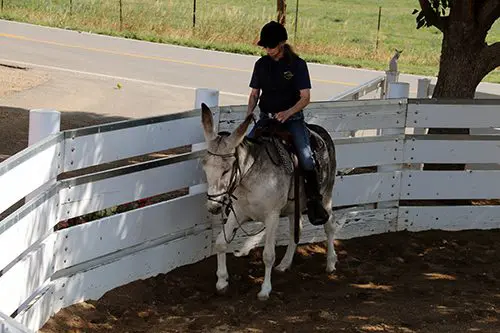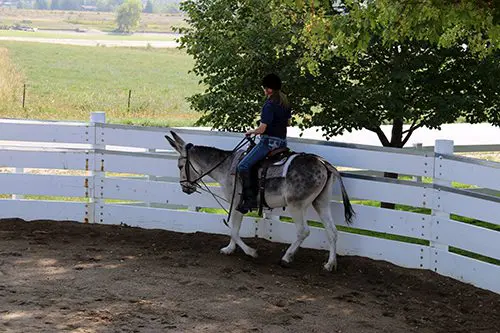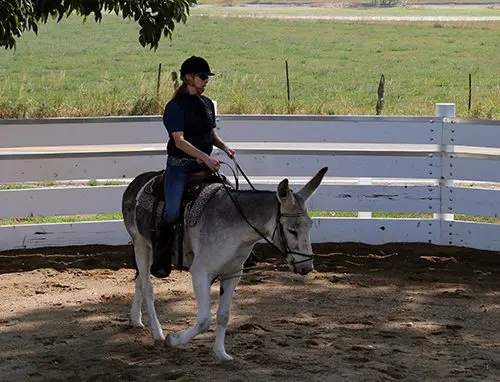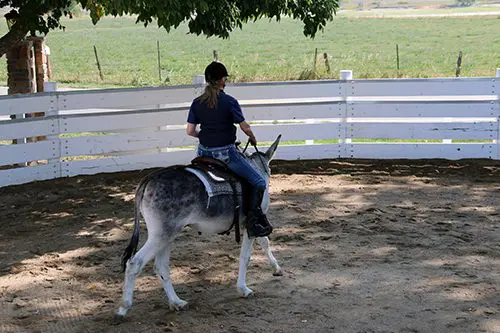WRANGLER’S DONKEY DIARY: Fine Tuning Wrangler’s Response: 9-22-20
Wrangler always eagerly awaits his weekly lessons! When things are predictable and are not “drilled,” your equine will look forward to his time with you. I always try to keep lessons short (30-40 minutes), done in a logical order and consistent in the task executions. For instance, we always walk the same way, with the lead in my left hand, with a loose connection to his head to encourage self-carriage, repeated verbal commands and I walk with my feet in sync with his front legs. The gates are always executed the same way. He is rewarded with crimped oats from my fanny pack when halted and waits patiently while I close and latch the gate. Even though Chasity is tied outside of the Round Pen, Wrangler’s attention is 100% on me. Minimizing distractions by being consistent with the way we do things will create a solid base of habitually good behavior.
Wrangler continues to stand quietly while I make sure his saddle is centered in the middle of his back and the tension on the crupper is adequate, but not too tight. He should be able to relax his tail. I check both girths to make sure they are snug but not too tight (the front girth tighter than the rear girth), adjust the tension on the “Elbow Pull” and make sure the fleece at the poll is centered to prevent undue chafing when he has to “lean” on the “Elbow Pull.” The “Elbow Pull” will not tie his head down, but it will prevent him from raising his head so high that he inverts his neck and spine. It will assure that he is in a good balanced equine posture during his workout.
I first ask Wrangler to walk for five rotations before asking him to trot. Occasionally, he will be so full of energy that he offers the trot first. If he trots, I just adjust and let him do five rounds of trot first and let him walk five rotation afterwards. To start, I only asked for walk and trot until Wrangler began to break into canter by himself. I then added one rotation at canter after the five rotations at trot before allowing him to walk.
I will add one more rotation at canter in each of the upcoming lessons. Then his warm-ups will consist of five rotations of each…walk, trot, canter, walk…then a reverse, and the same progression in the opposite direction before mounting him. He should always slow to a walk before executing the reverse so it is done in good postural balance.
This will begin to improve his balance and build his bulk muscle symmetrically.
After checking both girths one more time, Wrangler stands stock still as I mount him. I offer his oats on both sides as I did in our first mounting session in the Tack Barn. This is to make sure I keep his attention on ME! The oats are taken politely. He fully understands that these are NOT treats, only REWARDS for good behavior.
Once mounted and seated in balance, I ask Wrangler for a rein back with a few more steps than he had done in his previous lesson. He responds nicely to the squeeze/release motion of my little fingers.
I keep a very light contact with the bit as we proceed forward. We add circles at random points along the rail to add variety to the workout and keep it interesting. We work on staying erect while he bends to the arc of the circles through his rib cage.
Wrangler’s “Elbow Pull” remains consistently loose as he walks leisurely along the rail and executes the “S” turns for changes in direction.
Wrangler gives Chasity a wink as he passes the spot where she is tied along the rail. She is proud of how well her “beau” is doing and watches intently! Wrangler is soft, flexible and elastic in the bridle. This is exactly what I want from him. We will be able to graduate to a larger area next week!
Wrangler spotted a jogger coming toward us along the road and didn’t quite finish his square halt, but halted nevertheless. I prudently waited for the jogger to go by before I asked him for a rein back and he complied easily.
I think too many of us get in too much of a hurry to RIDE and forget that our equine athletes need the same consideration from us that human athletes get from their coaches. They need to do exercises that prepare their bodies for the “game.” When they are adquately prepared, their skeleton is symmetrically supported, joints are able to operate as intended and do not develop arthritis from uneven wear of the cartilage, and the internal organs can function in good health at maximum capacity. When we are patient and take the time to prepare our equines properly, there is much to be gained…a happy and willing equine companion that is capable of performing to their optimum ability. Training really CAN be safe and resistance-free! Being herdbound is not an issue because they really enjoy being with YOU as much as, if not more than, they enjoy being with their equine friends!




























